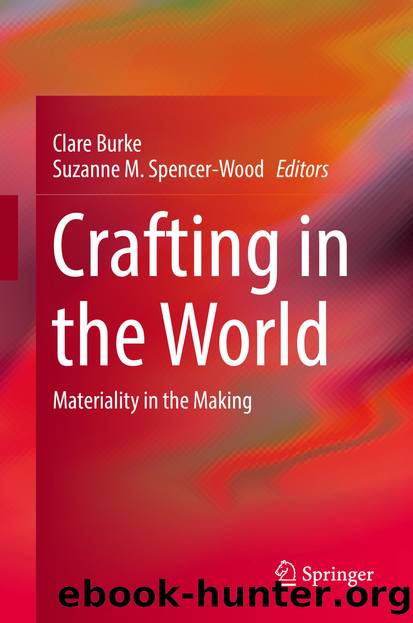Crafting in the World by Unknown

Author:Unknown
Language: eng
Format: epub
ISBN: 9783319650883
Publisher: Springer International Publishing
The Development of the Global Sloyd Manual Education Movement
The Sloyd manual education movement first developed in the Grand Duchy of Finland (which was part of Russian Empire 1809â1917) after the Russian Tsar Alexander II promised a new organization of primary schools, in gratitude for the loyalty of the Finns in resisting Napoleonâs invasion of Russia (Hansen 2009:8; Jowett and Snodgrass 2006:3; Stowe 2008a:60; Trotter 2006:4â5). A parish priest named Uno Cygnaeus (1810â1888) submitted his ideas for educational reform and was appointed director of the project. In 1858 he traveled to investigate educational systems in Germany, Austria, Switzerland, Holland, Denmark, and Sweden, and in 1861, his proposal was accepted for Finlandâs secular primary schools, which he called folk schools, established to train the hand, sense of form, and aesthetics and help âyoung menâ develop a general practical dexterity useful for all occupations. Folk schools were separated from the church (Dugger 2010:2â3), Froebelian kindergartens, and other craftwork in schools for older boys and girls.
Sloyd was first introduced in 1863 in the normal school for teacher training at Jyväskylä in central Finland, where only male teachers were required to learn methods of teaching Sloyd, despite the fact that the vast majority of elementary school teachers were women (Hoffman 1892:238). By 1892 special manual training courses were arranged for female teachers because reform women and their male allies in Europe and America had successfully argued that womenâs innately superior child-rearing skills made them better suited than men to be elementary school teachers (Spencer-Wood 2013:194). This argument grew out of Lockeâs valorization of all-powerful mothers in shaping young children into their lifelong adult character (Bloch 1978:50; Cott 1979:167â8; Locke 1693:261; 1824:13â80; Simons 1990:43), followed by Rousseauâs argument that women provide the most important early education of children in morals and taste preferences (Rousseau 2013:5,393). Mothersâ supposedly innately superior ability to educate young children was subsequently recognized by Pestalozzi (1885:129â31,135; 1830:2â7) and Froebel (1903:12â17) (Stowe 2017). Locke (1693:34â6, 84â5), Rousseau (2013:420), and Pestalozzi (1830:40â3) also cautioned mothers against overindulging and spoiling their children. In the eighteenth century, the earlier belief in the superiority of fathers as the moral instructors of their children was transformed into the belief in the moral superiority of mothers (Cott 1977:126â9; Lerner 1993:127â9,135; Rousseau 2013:5,18,393) as women by 1690 became 75% of church congregations (Cott 1977:126â7).
Initially the goal of the Sloyd manual education movement was to nostalgically preserve domestic crafts, called "hemslöjdâ that had declined as homemade products were increasingly replaced by inexpensive commercial products manufactured through capitalist industrial mass production (Salomon 1911:144â5). The decline of hemslöjd weakened rural families economically, physically, and psychologically (viewed as moral decline by those working to preserve helmslöjd), due to lack of purposeful physical activity during the long dark winter months. Since rural families formed at least 70% of the population in Finland and other Scandinavian countries as late as 1900, this was a serious problem that led governments to try to revive home crafts through subsidies to public schools for providing Sloyd courses and to students who took the courses (Larsson 1902:15; Salomon 1911:145,148; Vehkalahti 2009:73,78).
Download
This site does not store any files on its server. We only index and link to content provided by other sites. Please contact the content providers to delete copyright contents if any and email us, we'll remove relevant links or contents immediately.
The Japanese by Christopher Harding(1070)
Watercolor With Me in the Forest by Dana Fox(743)
A Theory of Narrative Drawing by Simon Grennan(737)
The Story of the Scrolls by The Story of the Scrolls; the M(720)
Glittering Images: A Journey Through Art From Egypt to Star Wars by Camille Paglia(698)
Boris Johnson by Tom Bower(615)
This Is Modern Art by Kevin Coval(588)
The Art and Science of Drawing by Brent Eviston(582)
Frida Kahlo by Frida Kahlo & Hayden Herrera(575)
AP Art History by John B. Nici(566)
Banksy by Will Ellsworth-Jones(562)
War Paint by Woodhead Lindy(541)
Van Gogh by Gregory White Smith(539)
Draw More Furries by Jared Hodges(535)
Scenes From a Revolution by Mark Harris(534)
About Looking by John Berger(530)
Ecstasy by Eisner.;(526)
100 Greatest Country Artists by Hal Leonard Corp(515)
Young Rembrandt: A Biography by Onno Blom(505)
